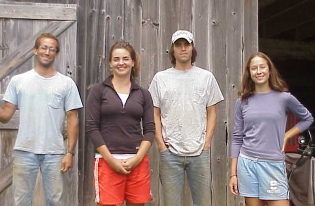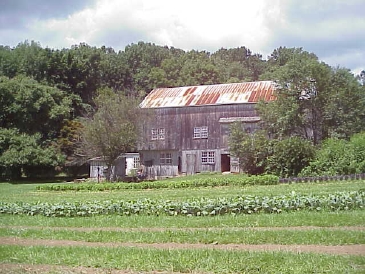Meet Maysie's Interns
By Kristy Deischer-Eddy
Hopefully you've had a chance to meet or at least greet our team of interns this year. They put in long, hard days to provide us with our wonderful food. Lauren, Jake and Sarah are leaving us soon to go back to school. On behalf of all the shareholders, we sincerely thank them for all their efforts!
Lauren Mandel is a senior at Skidmore College in Saratoga Springs, NY, majoring in environmental science and minoring in studio art (mainly sculpture and ceramics). She loves outdoor activities like rock climbing, camping, hiking, and white water rafting. Last summer Lauren worked as a ranger at the Pisgah National Forest in North Carolina, where she was involved in trail maintenance and educating visitors. She found Maysie's by looking on the internet for a farming internship, as she has a strong interest in sustainable agriculture and wanted to experience it firsthand. Lauren's favorite aspect of Maysie's is its emphasis on education with its variety of intern workshops.
Jake Gold grew up in West Chester and attended the Westtown School. He will be a sophomore in the fall at Carlton College in Northfield, MN. Yet to declare a major, Jake is interested in environmental studies, geology, and Spanish. He likes camping and traveling Ð this August he spent 10 days in China visiting an exchange student that his family hosted. He is also a fearless bike rider and has been spotted riding along some of our busiest roads! Jake came to Maysie's as an intern because he wanted to learn firsthand what it takes at an organizational level to run a Community Supported Agriculture program. His favorite part of his internship is working outside with his coworkers.

Andy, Sarah, Mike and Lauren
(Jake is absent due to a trip to China) |
Sarah Jones, a native of West Chester, is a junior at Carlton College, majoring in cognitive science. She plays lacrosse at school, and also works at the library and as a DJ for the college radio station. Sarah was familiar with Maysie's Farm as her parents used to be shareholders here. She likes the concept of CSAs because she wants people to know their connection to their food. She also enjoys working outside and was looking for experience on a farm. A long-term goal of Sarah's is to run her grandparents' farm in Avondale with her brother. She will be spending the fall semester in Siena, Italy, where she will study studio art and Italian.
Mike Bailey is originally from Harrisburg and now lives in University City, Philadelphia. A recent law school graduate, he worked for the Fair Food Project, which helps connect food growers with retail outlets in the city. Mike enjoys cooking local, healthy food and feeding people in his neighborhood. He is interested in public policy and would like to help people buy houses or plots in which to garden. Mike one day hopes to have a farm or a retail establishment of his own. He enjoys working outdoors and says it's useful work that contributes more to society than did his recent work as a bike messenger.
Flower Fanatics at Maysie's
by Lucia Dorsey
There's been a hint of the European street-side flower vendor lately in Maysie's barn. Are we on holiday in Europe? No, we're still on this side of "the pond." You may have noticed a new burst of color and fragrance in the back corner when collecting your produce shares on pick-up day. Dorian Hill Flower Farm in Chester County is offering fresh, locally grown cut flowers to Maysie's customers for the first time during the 2004 season.
Unlike many Europeans, Americans do not (yet!) typically buy cut flowers in abundance for everyday use. But flowers do play a significant role in our lives in many ways. As traditional decorations for important family and community events — from elaborate weddings and state occasions, to birthday parties and potluck dinners — flowers have graced our tables, entrance halls, public buildings, and places of worship for centuries. Often imbued with symbolic meaning, fresh flowers have always been the first choice for bridal bouquets and the perfect gift for anniversaries, Valentine's Day, and other holidays and milestones.
In addition to their ceremonial uses, flowers are an integral part of stylish interior design. Nothing completes the look of a room, dining table, or office reception area more beautifully than an arrangement of fresh flowers. There is no more eloquent "welcome" than a vase of flowers in the foyer or on a bedside table in the guestroom.
Finally, fresh flowers are one of the simplest ways to satisfy our desire to connect with nature and bring its beauty indoors. The bright colors and scents in even the smallest bouquet can lift the spirits and soothe the soul. Some ace gardeners keep their flowers attached to the plant because they haven't the time or inclination to arrange them in vases. Other flower lovers have either not been gifted with a green thumb, or else lack the time and space to use it. If you fall into one of these categories, or somewhere in between, the flower fanatics at Dorian Hill Flower Farm are ready to help.
My mother, Jean Iannone, and I started Dorian Hill in 2002 out of a passion for gardening and flower arranging. We hand-select only the best blossoms to create mixed bouquets in an old-fashioned, cottage-garden style. The bouquets change with the seasons. Spring ushers in thousands of yellow and white daffodils, along with forsythia, Siberian iris, purple alliums, azalea, dogwood, rhododendron, and pink peonies. Summer on the farm is a riot of color with yarrow, snapdragons, zinnias, purple and white butterfly bush, cosmos, sweet William, purple and yellow coneflower, pale pink lisianthus, Shasta daisies, pink and white Oriental lilies, Russian sage, bells of Ireland, purple salvia, nicotiana, and phlox. Many of these continue into the fall, accompanied by New England asters, pink sedum, blue caryopteris, orange Mexican sunflower, and creamy hydrangea.
Our bouquets are a cut above because we use only organic growing methods. Our flowers last longer because they're locally grown and delivered within a day of harvesting. Most floral stock at the supermarket and florist is shipped long distances, resulting in higher costs, lack of freshness, and less variety, since many types of flowers do not ship well. If you love flowers and care about organic farming and supporting local family farms, then give us a try. We bring bouquets to Maysie's most Fridays. You can also call or e-mail us a couple of days ahead to order your bouquets. We'll deliver them to Maysie's on your next pick-up day. Ask us about our bouquet delivery service for residential and business customers. We can also provide flowers for small parties, weddings, and corporate events. Let us make you into a flower fanatic, too! Dorian Hill Flower Farm, (610) 644-8272, dorsey@verizon.net.

|
Good Neighbor Lighting
by Daniel Barringer
The urban sky glow has arrived in Chester County. The pink radiance in the night sky associated with wasted light has moved beyond the city and now can be found in places that used to be dark farm fields and woods. As land is developed many resources are affected; one often overlooked is that of darkness.
Yes, darkness. The view of the starry night sky is a natural and cultural resource; these days, it is fully enjoyed only by people who live in dark rural areas. Poorly designed lighting takes away that resource and wastes energy, creates glare, and can reduce property values.
The New England Light Pollution Advisory Group and International Dark-Sky Association (IDA) print a brochure that describes good lighting and the problems it avoids. Good lighting illuminates the walkway, doorway, driveway or other target area while minimizing the light that fills the sky. The International Dark Sky Association has extensive resources on its website (www.darksky.org) — from how to talk to a neighbor about glare to how to write a lighting ordinance.
Wildlife can be affected by artificial lighting: it may experience attraction, fixation, or repulsion; disorientation or improvement in orientation; disruption of biological rhythms; and change in habitat quality. For example, some insects, migrating toads, and salamanders are attracted to light, increasing their chances of being preyed upon or run over. Hatchling sea turtles have a documented attraction to light, drawing them away from what would naturally be the brightest area: the reflected light of the sea to which they need to migrate. Some species of birds may be disoriented by artificial light, resulting directly in death or lower reproductive success. Artificial lighting can also disrupt the internal rhythms that regulate the activities of animals, resulting in exhaustion, early brooding, and other physiological functions (IDA Information Sheet #187).
Overly bright lighting makes shadows seem darker. To avoid glare — the direct view of the lighting source or bulb — light fixtures should be shielded to direct light downward. Light that floods a neighboring property is called "light trespass" and invades privacy.
Quality lighting fixtures use high efficiency lamps to save energy while still considering the color and quality of light. The fixture should be located where light is needed, not projecting light from a great height or distance.
The level of lighting appropriate in a rural area is different than a city. Well-designed lighting can be used to meet people's needs while helping to preserve the nighttime rural character of parts of the county.
[A version of this article will be printed in the Warwick Township newsletter. Thanks to Stan Stubbe, local lighting consultant for municipalities, for sources of information.]
Editor's note —
Sam feels so strongly about light pollution that he wanted to add a few words to Dan's article:
 This issue is really very simple: lights should not be on if no one is there. Period. Inside the building or outside the building, if no one's in the room, if no one's in the area, the lights should not be on. To have a light on when no one is there serves no useful purpose whatsoever and causes a great deal of harm. Most of all, it's a waste of energy — and as such, it contributes to global climate change, deforestation, desertification, cultural disruption, social inequities, poverty, war, pollution and the home or business owner's financial stress — and provides no benefit at all. Light pollution disrupts wildlife, decreases visibility in surrounding areas (due to glare and shadow), is esthetically offensive to some people (such as yours truly) and, if no one is there to use the light, it serves no useful purpose whatsoever (or did I already say that?). This issue is really very simple: lights should not be on if no one is there. Period. Inside the building or outside the building, if no one's in the room, if no one's in the area, the lights should not be on. To have a light on when no one is there serves no useful purpose whatsoever and causes a great deal of harm. Most of all, it's a waste of energy — and as such, it contributes to global climate change, deforestation, desertification, cultural disruption, social inequities, poverty, war, pollution and the home or business owner's financial stress — and provides no benefit at all. Light pollution disrupts wildlife, decreases visibility in surrounding areas (due to glare and shadow), is esthetically offensive to some people (such as yours truly) and, if no one is there to use the light, it serves no useful purpose whatsoever (or did I already say that?).
If township ordinances mandated that exterior lights be on motion (or heat) detectors, we'd have all the outside light we needed (if someone were there, the light would be on) and THINK OF THE ENERGY WE'D SAVE!

Bennie guarding a stick
ATTENTION, SHAREHOLDERS!
Please remember that food is harvested ONLY FOR THE AMOUNT OF SHARES that are picking up that day. If you come unannounced on a different day, or if you take more than what is specified on the board, there will not be enough food for the rest of the people picking up that day. Please be considerate.
Also, for households that are sharing shares: if you have purchased only a small share, that does not entitle BOTH households to a small share each week — you are supposed to be sharing it! If you have any questions about this, or if you want to upgrade your share size, please talk to Sam or a Distribution Manager.
Finally, please don't forget to sign in each week. While you're at it, why not order raw milk products, chickens and eggs, and/or organic beef and pork? It's an easy and delicious way to support other local food sources. And don't forget the flowers — those orders can be made via e-mail to dorsey@verizon.net at least 3 days prior to your pick up day.
|



